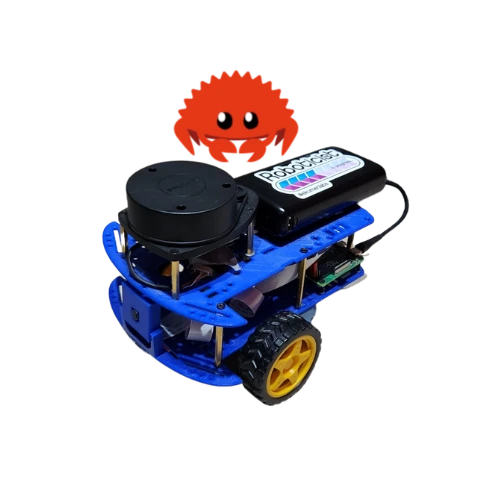We’re excited to announce a new addition to the andino ecosystem: andino-rs. This project brings Andino closer to the Rust world, a feature desired by many who want to dive into robotics using Rust as the main language.
andino-rs. integrates with dora, a middleware designed to streamline and simplify the creation of AI-based robotic applications, opening the door to use your educational robot for your AI model validation and prototyping.
The Power of Rust for andino 🦀

The robotics industry has long been dominated by C++ for performance-critical code and Python for high-level logic and rapid prototyping. However, a significant trend is now emerging with the adoption of Rust for low-level systems. Developers are recognizing that Rust offers a compelling alternative to C++, providing similar fine-grained control while its strong memory safety guarantees prevent entire classes of bugs—a critical feature for reliable physical systems. This allows for a robust core that pairs powerfully with the high-level Python APIs that are still used for orchestration and research.
With the “Rust in Robotics” community growing and more tools becoming available, Rust is solidifying its place in the next generation of robots. Our decision to build andino-rs is a step towards embracing this future, driven by Rust’s key advantages:
- Performance: Rust provides C-level performance with zero-cost abstractions, essential for real-time processing on embedded systems.
- Safety: Its compile-time memory safety guarantees eliminate common bugs, leading to more robust and reliable robotic applications that you can trust.
- Modern Tooling: Out-of-the-box build system and package manager via cargo. And tooling for test, benchmarking, and doc creation leads to managing dependencies and building projects being straightforward and efficient.
Integrating andino with dora 🤖
andino-rs provides integration with dora, a next-generation, dataflow-oriented framework for robotics. As part of this integration, several dora nodes were created to serve andino-rs’ purposes that could become useful to the dora’s community as well.
This integration establishes a powerful and flexible pipeline for deploying complex applications, particularly those that leverage AI.
By combining andino-rs with dora, developers can now:
- Easily build modular, high-performance robotics applications.
- Create nodes that communicate seamlessly over the dora network.
- Directly integrate and run AI models, allowing Andino to learn new skills in dynamic, data-driven ways.
PoC: Controlling Andino with Google’s Gemini LLM 🧠

To showcase the power of this new architecture, we created a proof-of-concept that puts a Large Language Model (LLM) in the driver’s seat.
Using dora, we built a simple dataflow graph where natural language commands—like “move forward” or “move to the red sphere”—are sent to a node running Google’s Gemini model. The LLM interprets the command and generates the corresponding Twist message for controlling the differential drive robot.
The result is a robot that can be controlled directly through conversational language. Of course, using a generic LLM like Gemini and relying entirely on cloud inferences, it is far from being a validated robotic stack that you want to use in your commercial robot. Hopefully, these aspects are tackled by the Gemini Robotics variant. Nonetheless, this example highlights how surprisingly easy it is to integrate cutting-edge AI services into a robotics workflow. You can explore the dora graph for this demo here. This is just the beginning. We look forward to creating more AI-based workflows and even trying hybrid approaches.
Get Involved!
We are just getting started and invite you to explore this new frontier for the Andino project.
- Check out the project on GitHub: Ekumen-OS/andino-rs
- Explore the ecosystem: See the original andino project.
- Star the repo, try it out, open an issue, or submit a pull request. We look forward to seeing what you build!